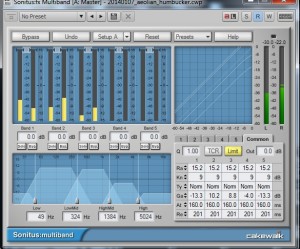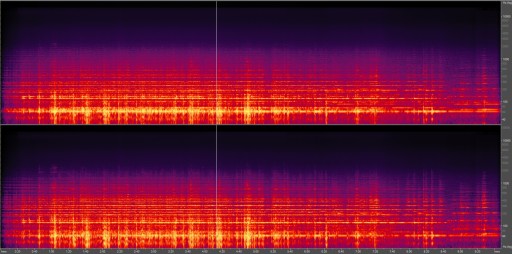
The mp3 is a bit large and runs on your side so there is some latency before it starts playing.
DIY Electric Aeolian Harp – Humbucker Version – Ahead of a storm that came through on the past weekend I quickly cobbled together an electric aeolian harp built from a 4″ x 4′ x 0.5″ pine plank, a couple pine 1″ x 1″ risers, 6 zither pins, 2 very cheap humbucking pickups, an odd ball collection of strings from 0.160″ to 0.013″ and two short lengths of bass guitar wound strings as bridge and nut held by tension on top of the risers. The pick ups were wired as a stereo pair with common ground and the signal sent to a Zoom H2 set with high sensitivity and compression 2. The auto record function was used to sample day and night over some 36 hours. What you hear here has been minimally mastered. The EQ is as follows in the graphic below. I tried to reduce the hiss and the “bumping” without destroying the ambiance of the wind-played strings. The bumps I think are from the plank moving from the strong wind.
The piece is composed of 3 files each from five folders of samples arranged in overlapping but roughly chronological fashion. With each folder I tweaked the tuning with makes itself apparent throughout the semi-aleatoric composition. A very evident change in tuning occurs in the last minute or so which I sense as a denial of the tonic set up by the recurrent drone in the preceding section. If you look at the spectral view in detail this change in tuning is very evident. In case you are not aware, an Aeolian Harp when played by the wind does not sound the fundamental. All you hear are harmonics of the strings and the strings were tuned by ear into just intonation relationships (more or less).
Some of the lessons I’m taking away from this:
1. Strings – more strings! Though I am kean to try a sing string one day.
2. The bridge pickup is far too weak. I will be moving it more towards the center. What you hear is still heavy on the middle pick up even after I changed the master panning.
3. Need to secure the instrument much better so it will not bump. I’ll admit I was running out of time and the zip ties were breaking in the cold.
4. I am not sure if I hear it… debatable – I purposefully crossed the 0.013″ and 0.017″ gauge strings which gives a ring modulation type sound. I have several hundred samples to wade through (you hear only some of the longest here) before I make up my mind. The high piecing note you hear at a point or two in this composition I am pretty sure is from the 0.013″ after I removed the 0.017″ string. (for no other reason than to keep changing things as I sampled the wind)
5. The humbuckers totally wiped out the 60 cycle hum that was so difficult to remove. Obviously this is the way to go.
This harp is a refinent of my original long string piezo version


9 replies on “DIY Electric Aeolian Harp – Humbucker Version”
Hi I would be happy to help you. You may be interested in my new album “The Electric Aeolian Harp” http://chrisvaisvil.bandcamp.com/album/the-electric-aeolian-harp
Hi, Chris,
I’m Santiago, writing to you from Bogota, Colombia. I have a foundation called Nova et Vetera. Basically we have been working on performing arts and avant-garde music for 7 years. We have invited several artists, composers and ensembles to Colombia from the United States and Europe and we work a lot with the local scene. I found your work on the internet just now, researching about Kircher’s Wind Harp and your electric version. And of course I spent several hours listening to your music and reading the excellent entries on the site. I wanted to contact you because we are approaching a grant to make an electric eolic harp in Bogotá and invite a number of multidisciplinary artists to collaborate on it. We would love to have your advice and expertise if you are interested and maybe send you some files to try to compose something new with sounds from the winds of Bogotá… In these times of confinement it is just as interesting to collaborate by exploring together!
Do you think it could be something that would interest you?
I’ll keep an eye out, maybe we could talk on the phone or zoom in.
Greetings and thanks for sharing your work
I mostly tune by ear and only rarely used a guitar tuner to try for 12 equal and then adjust to Just Intonation which is my preference. After saying that I can’t say I’ve purposely tried A=432 Hz. As for the wood, this is essentially an outdoor electric guitar. I think the wood is not as important as in all acoustic versions which are beyond my wood working skills.
Have you tried to tune this instrument to the solfeggio 432 hz???; also I have a question: according to your own experience ,what kind of wood is better for the acoustical tonality of it?, thank you and Ill appreciate any help, thanks a lot.
Thank you!
this is beautifuly magical ,otherworldly sounds, wooowwww!!!!! , the UFOs are comming!!!!!!!!!!!
[…] 20 minutes in length – this is to give the listener a feel for what its like to listen to the aeolian harp live with all of the fickleness of the interaction of wind and string. In the picture is detail of a […]
As a player of harmonic flute I dig it. Strings need to be elevated to catch wind better. Zip ties are for permanent use only, there is enough plastic trash. Get a clamp or two.
Cool instrument